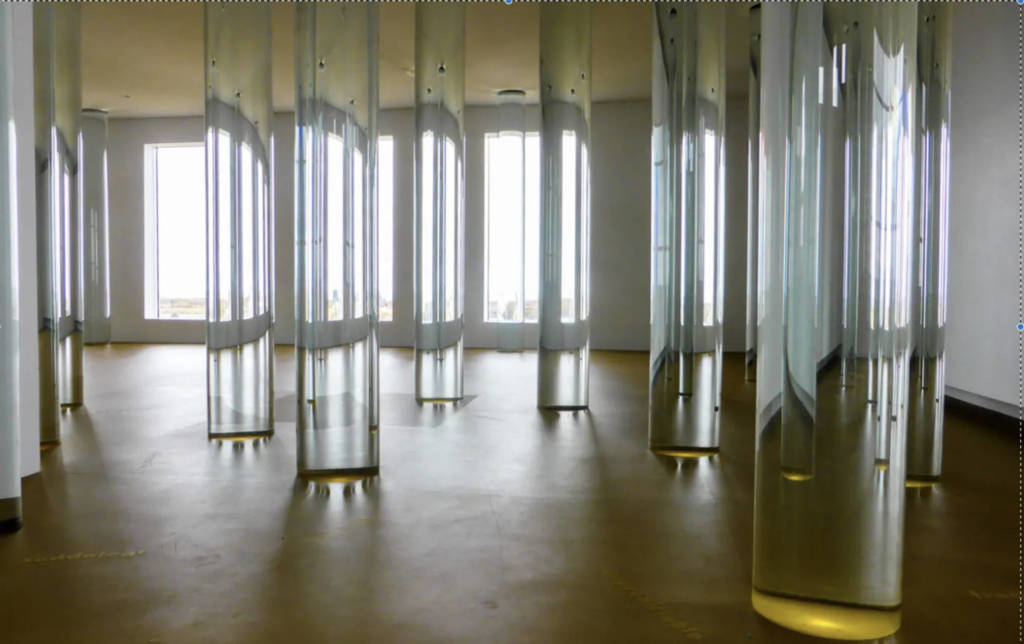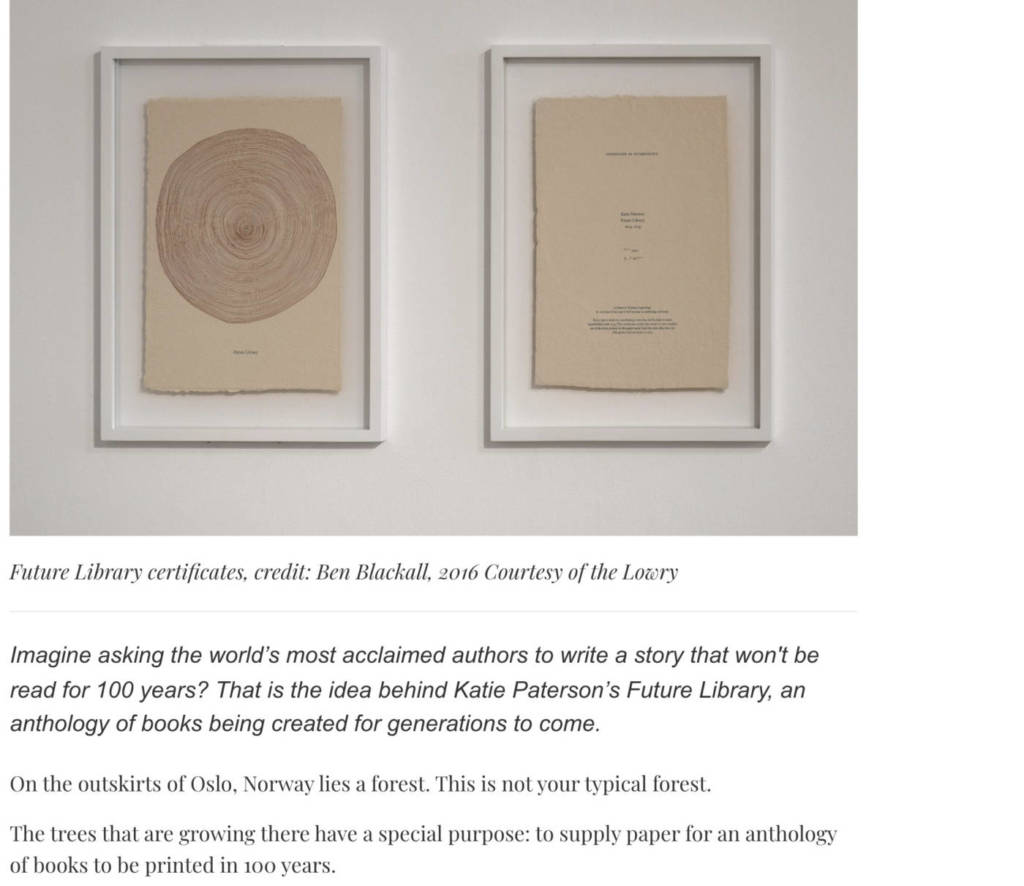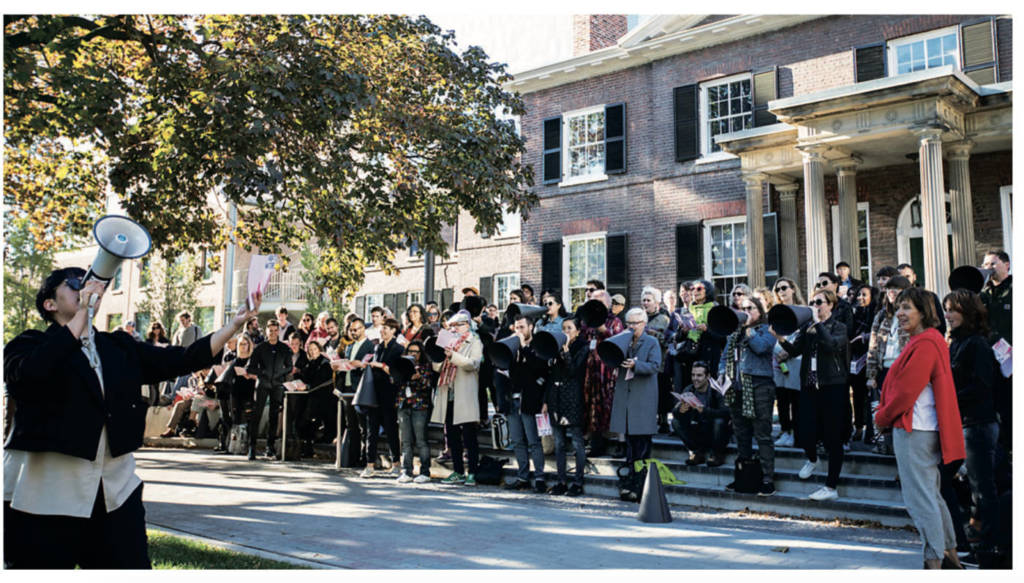- Several references are from the readings
- WORLD ON FIRE: How should Art Reckon with Climate Change? New York Times Magazine, 2022.
2. Dowsing for Remediation with Alana Bartol, Valérie Frappier, C Magazine 2022. PDF on blog.
3. Plastiglomerate: On Kelly Jazvac, Kirsty Robertson, e-flux journal, 2016. Article link
What is the ethical duty of artists?
Environmentalist Bill McKibben asked –
“Where are the books? The poems? The plays? The goddamn operas?” he wrote in an op-ed for Grist. “Compare it to, say, the horror of AIDS … which has produced a staggering outpouring of art that, in turn, has had real political effect.” For future generations looking back on the present, “the single most significant item will doubtless be the sudden spiking temperature. But they’ll have a hell of a time figuring out what it meant to us.”
What can art and artists actually do?
Chicago-based curator and early supporter of environmental art Stephanie Smith cautioned that a glut of superficially righteous exhibitions could give hits of easy virtue to viewers and museums alike –
“If sustainability or climate change become art trends du jour, we risk providing a palliative to ourselves and to our audiences without contributing much to artistic production, nuanced debate or lasting social change”
How are artists representing the environment?
Representing nature as the sublime and untouched – Thomas Cole

Spoiled and poisoned, developed – Ed Burtinsky


How are contemporary artists re-imagining our place in the natural world, and proposing alternative relationships with our environment?
Imagining alternative relationships – Mary Mattingly, Future Farmers

https://www.artnews.com/gallery/art-in-america/aia-photos/swale/2-12165/
Amy Franchescini (Future Farmers)
Making the absurdity of our moment visible –
Space of persuasion/affective experience of large and complex concepts –
Educating/making the scope of the catastrophe felt – and ACTUAL remediation: Alana Bartol
https://alanabartol.com/home.html


The artists is interested in reciprocal relationships to land, and asks – “How do (I and other settlers) actually relate to land, and to what it’s already communicating?
She is exploring “extractive capitalism” while simultaneously “entangled with and benefitting from it.”
Kelly Jazvac– Plastiglomerates:

“In 2013, at the suggestion of oceanographer Charles Moore, geologist Patricia Corcoran and artist Kelly Jazvac travelled to Kamilo Beach, Hawaii to study a new stone formation. What they found was a new substance that was a mix of melted plastic and natural materials such as coral, sand, wood and volcanic rock. They called the stones “Plastiglomerate” and a co-authored manuscript of their findings can be found here: http://www.geosociety.org/gsatoday/archive/24/6/article/i1052-5173-24-6-4.htm
From Kelly Jazvac

“Human action on the beach had created what Corcoran and Jazvac named “plastiglomerate,” a sand-and-plastic conglomerate. Molten plastic had also in-filled many of the vesicles in the volcanic rock, becoming part of the land that would eventually be eroded back into sand.”
“The term “plastiglomerate” refers most specifically to “an indurated, multi-composite material made hard by agglutination of rock and molten plastic. This material is subdivided into an in situ type, in which plastic is adhered to rock outcrops, and a clastic type, in which combinations of basalt, coral, shells, and local woody debris are cemented with grains of sand in a plastic matrix.” (KJ) More poetically, plastiglomerate indexically unites the human with the currents of water; with the breaking down, over millennia, of stone into sand and fossils into oil; with the quick substration of that oil into fuel; and with the refining of that fuel into polycarbons—into plastic, into garbage. “

“The naming and dating of the Anthropocene, an as-yet formally unrecognized and heavily debated term for a geologic epoch evidencing human impact on the globe, relies “on whether humans have changed the Earth system sufficiently to produce a stratigraphic signature in sediments and ice that is distinct from that of the Holocene epoch.
Whichever (if any) start date is chosen, plastiglomerate—a substance that is neither industrially manufactured nor geologically created—seems a fraught but nonetheless incontrovertible marker of the anthropogenic impact on the world; it is evidence of human presence written directly into the rock.
After collection, the samples gathered at Kamilo Beach were analyzed so as to categorize the plastics and the natural sediments that together created the plastiglomerate whole. Following this, Jazvac showed the plastiglomerate in art exhibitions as sculptural ready-mades, to demonstrate human impact on nature.

Plastic soon shed its utopian allure, becoming hard evidence for the three c’s—the triple threat of capitalism, colonialism, and consumerism—as well as a kind of shorthand for all that was inauthentic and objectionable about postwar everyday life.
Plastiglomerate is a remainder, a reminder, an indicator of the slow violence of massive pollution. It brings together deep geological time and current consumerism.
Plastiglomerate is what Heather Davis calls “accidentally or incidentally” aesthetic. It is precisely the facticity of plastiglomerate, its infrangibility, its constituent components and analysis as both artwork and geological specimen that make it fascinating. Plastiglomerate demonstrates an already existent artistic relationship between human and planetary action that can’t really be improved by rendering that relationship as solely human. Or perhaps more disturbing still, it demonstrates the Anthropocene as a performance, an artwork with the end act of planetary destruction.

The ready-made geologic being of plastiglomerate speaks to more than pollution: also geology, the deep time of Earth, colonization, human-animal knowledges, currents of water, and the endless unfolding and collapse of life on Earth. We might conclude that “we have come into existence with and because of so many others, from carbon to microbes to dogs. And all these creatures and rocks and air molecules and water all exist together, with each other, for each other. To be a human means to be the land and water and air of our surroundings.”
Excerpts from Plastiglomerate: On Kelly Jazvac, Kirsty Robertson, e-flux journal, 2016.
Spaces of reflection, remembrance –

Roni Horn, Library of Water, 2007 – ongoing
https://www.west.is/en/service/library-of-water
Transform our experience of time/scale of our lives relative to the world – John Cage, Katie Patterson






Modelling/embodying alternative cultures and worldviews –Tania Willard, Bush Gallery
BUSH MANIFESTO:


READ THE MANIFESTO:
https://cmagazine.com/issues/136/bush-manifesto
–
Protest, fight – Public Studio


Express hope/resist cynicism and apathy –
Transform/reduce environmental impact of art’s production and exhibition –
Tara Donovan and Piet Hein Eek – who have made discarded, everyday materials the centre of their work. Watch their exciting approach to re-using materials. “The materials wait to be used again.” British sculptor Phyllida Barlow (b.1944) uses materials from her former sculptures – from their experimental stage. To Barlow, sculpturing is not about perfection but about recovering lost moments. Flexibility is key to American artist Elliott Hundley (b. 1975), who uses materials he’s found washed up on a beach in his artwork. Wrapping paper, rocks and beads are all part of a magnificent collage pieced together by chicken wire and straight pins. “In a way the artist works with remnants, society’s remnants.” Danish poet, writer and artist Morten Søkilde (b. 1974) dubs himself “a thing-finder” and uses these things he finds on e.g. the street to create his poetic, dream-like miniature models. When re-using materials in such a manner, there are suddenly infinite possibilities, and one’s own ideas are the only limitation. American fabric sculptor and performance artist Nick Cave (b. 1959) describes his art as “a second skin that hides gender, race, class.” An array of discarded materials makes up his artwork, and he often frequents thrift stores and flea markets, searching for something “that has a pulse to it” and can be the beginning of something new. “It always starts with material,” says Dutch designer Piet Hein Eek (b. 1967), who uses e.g. scrap wood to build furniture – his goal being to optimize and take maximum advantage of the things around him. Starting out, people thought he was crazy to use leftover-material, but his approach has now set a new trend. American artist Tara Donovan (b. 1969) was initially drawn to everyday materials – such as straws – because they were easily accessible, inexpensive and mass-produced. She works to the point where the flexible material, which makes up her magical sculptures, transcends itself, thus creating a sort of artistic structure. All interviews by Marc-Christoph Wagner, Christian Lund and Jonas Hjorth, Louisiana Museum of Modern Art.
